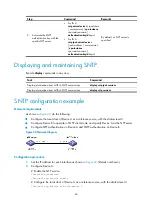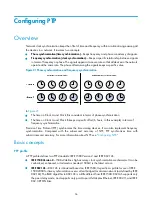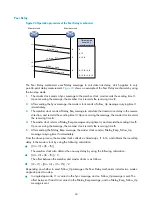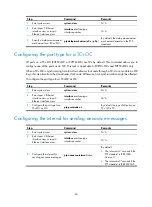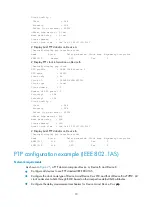
68
Specifying the protocol for encapsulating PTP messages as UDP
(IPv4)
PTP messages can be encapsulated in IEEE 802.3/Ethernet packets or UDP packets.
To configure the protocol for encapsulating PTP messages as UDP (IPv4):
Step Command
Remarks
1.
Enter system view.
system-view
N/A
2.
Enter Layer 2 Ethernet
interface view or Layer 3
Ethernet interface view.
interface
interface-type
interface-number
N/A
3.
Configure the protocol for
encapsulating PTP messages
as UDP (IPv4).
ptp transport-protocol udp
By default, PTP messages are
encapsulated in IEEE
802.3/Ethernet packets.
Specifying the source IP address for UDP packets
Step Command
Remarks
1.
Enter system view.
system-view
N/A
2.
Enter interface view.
ptp
source
ip-address
[
vpn-instance
vpn-instance-name
]
By default, no source IP address is
specified for PTP messages
encapsulated in UDP packets.
Configuring the delay correction value
PTP performs time synchronization based on the assumption that the delays in sending and receiving
messages are the same. However, this is not practical. If you know the offset between the delays in
sending and receiving messages, you can configure the delay correction value for more accurate time
synchronization.
To configure the delay correction value for every clock node:
Step Command
Remarks
1.
Enter system view.
system-view
N/A
2.
Enter Layer 2 Ethernet
interface view or Layer 3
Ethernet interface view.
interface
interface-type
interface-number
N/A
3.
Configure delay correction
value.
ptp
asym-correction
{
minus
|
plus
}
value
Optional.
The default is 0 nanoseconds,
which means delay correction is
not performed.
Summary of Contents for 5920
Page 86: ...76 XGE1 0 2 N A P2P Two 0 ...

